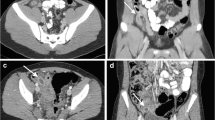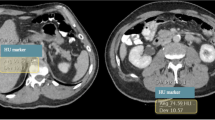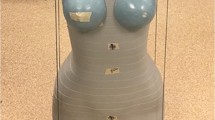Abstract
Objectives
To systematically explore the lowest reasonably achievable radiation dose for appendiceal CT using an iterative reconstruction (IR) in young adults.
Methods
We prospectively included 30 patients who underwent 2.0-mSv CT for suspected appendicitis. From the helical projection data, 1.5-, 1.0- and 0.5-mSv CTs were generated using a low-dose simulation tool and the knowledge-based IR. We performed step-wise non-inferiority tests sequentially comparing 2.0-mSv CT with each of 1.5-, 1.0- and 0.5-mSv CT, with a predetermined non-inferiority margin of 0.06. The primary end point was the pooled area under the receiver-operating-characteristic curve (AUC) for three abdominal and three non-abdominal radiologists.
Results
For the abdominal radiologists, the non-inferiorities of 1.5-, 1.0- and 0.5-mSv CT to 2.0-mSv CT were sequentially accepted [pooled AUC difference: 2.0 vs. 0.5 mSv, 0.017 (95% CI: -0.016, 0.050)]. For the non-abdominal radiologists, the non-inferiorities of 1.5- and 1.0-mSv CT were accepted; however, the non-inferiority of 0.5-mSv CT could not be proved [pooled AUC difference: 2.0 vs. 1.0 mSv, -0.017 (-0.070, 0.035) and 2.0 vs. 0.5 mSv, 0.045 (-0.071, 0.161)].
Conclusion
The 1.0-mSv appendiceal CT was non-inferior to 2.0-mSv CT in terms of diagnostic performance for both abdominal and non-abdominal radiologists; 0.5-mSv appendiceal CT was non-inferior only for abdominal radiologists.
Key points
• For both abdominal and non-abdominal radiologists, 1.0-mSv appendiceal CT could be feasible.
• The 0.5-mSv CT was non-inferior to 2.0-mSv CT only for expert abdominal radiologists.
• Reader experience is an important factor affecting diagnostic impairment by low-dose CT.



Similar content being viewed by others
Abbreviations
- IR:
-
Iterative reconstruction
- AUC:
-
Area under the receiver-operating-characteristic curve
References
Drake FT, Florence MG, Johnson MG et al (2012) Progress in the diagnosis of appendicitis: a report from Washington State's Surgical Care and Outcomes Assessment Program. Ann Surg 256:586–594
Park JH (2014) Diagnostic imaging utilization in cases of acute appendicitis: multi-center experience. J Korean Med Sci 29:1308–1316
Yun SJ, Ryu CW, Choi NY, Kim HC, Oh JY, Yang DM (2017) Comparison of low- and standard-dose CT for the diagnosis of acute appendicitis: a meta-analysis. Am J Roentgenol 208:W198–W207
Kim K, Kim YH, Kim SY et al (2012) Low-dose abdominal CT for evaluating suspected appendicitis. N Engl J Med 366:1596–1605
Aly NE, McAteer D, Aly EH (2016) Low vs. standard dose computed tomography in suspected acute appendicitis: Is it time for a change? Int J Surg 31:71–79
Willemink MJ, Leiner T, de Jong PA et al (2013) Iterative reconstruction techniques for computed tomography part 2: initial results in dose reduction and image quality. Eur Radiol 23:1632–1642
Zabic S, Wang Q, Morton T, Brown KM (2013) A low dose simulation tool for CT systems with energy integrating detectors. Med Phys 40:031102
Muenzel D, Koehler T, Brown K et al (2014) Validation of a low dose simulation technique for computed tomography images. PLoS One 9:e107843
Mei K, Kopp FK, Bippus R et al (2017) Is multidetector CT-based bone mineral density and quantitative bone microstructure assessment at the spine still feasible using ultra-low tube current and sparse sampling? Eur Radiol. https://doi.org/10.1007/s00330-017-4904-y
Dowlati A, Robertson K, Radivoyevitch T et al (2005) Novel phase I dose de-escalation design trial to determine the biological modulatory dose of the antiangiogenic agent SU5416. Clin Cancer Res 11:7938–7944
Bossuyt PM, Reitsma JB, Bruns DE et al (2015) STARD 2015: An updated list of essential items for reporting diagnostic accuracy studies. Radiology 277:826–832
Deak PD, Smal Y, Kalender WA (2010) Multisection CT protocols: sex- and age-specific conversion factors used to determine effective dose from dose-length product. Radiology 257:158–166
Martin CJ, Sookpeng S (2016) Setting up computed tomography automatic tube current modulation systems. J Radiol Prot 36:R74–R95
Ahn S (2014) LOCAT (Low-dOse Computed tomography for Appendicitis Trial) comparing clinical outcomes following low- vs standard-dose computed tomography as the first-line imaging test in adolescents and young adults with suspected acute appendicitis: study protocol for a randomized controlled trial. Trials 15:28
Joo SM, Lee KH, Kim YH et al (2009) Detection of the normal appendix with low-dose unenhanced CT: use of the sliding slab averaging technique. Radiology 251:780–787
Kim SY, Lee KH, Kim K et al (2011) Acute appendicitis in young adults: low- versus standard-radiation-dose contrast-enhanced abdominal CT for diagnosis. Radiology 260:437–445
Seo H, Lee KH, Kim HJ et al (2009) Diagnosis of acute appendicitis with sliding slab ray-sum interpretation of low-dose unenhanced CT and standard-dose IV contrast-enhanced CT scans. Am J Roentgenol 193:96–105
LOCAT group (2017) Low-dose CT for the diagnosis of appendicitis in adolescents and young adults (LOCAT): a pragmatic, multicentre, randomised controlled non-inferiority trial. Lancet Gastroenterol Hepatol 2:793–804
Lee YJ, Kim B, Ko Y et al (2015) Low-dose (2-mSv) CT in adolescents and young adults with suspected appendicitis: advantages of additional review of thin sections using multiplanar sliding-slab averaging technique. Am J Roentgenol 205:W485–W491
Rosai J, Ackerman LV (2011) Appendix. In: Rosai J (ed) Rosai and Ackerman's surgical pathology. Mosby, St. Louis, pp 714–718
Westfall PH, Krishen A (2001) Optimally weighted, fixed sequence and gatekeeper multiple testing procedures. J Stat Plan Inference 99:25–40
Gallas BD (2006) One-shot estimate of MRMC variance: AUC. Acad Radiol 13:353–362
Obuchowski NA, Gallas BD, Hillis SL (2012) Multi-reader ROC studies with split-plot designs: a comparison of statistical methods. Acad Radiol 19:1508–1517
Park JH, Kim B, Kim MS et al (2016) Comparison of filtered back projection and iterative reconstruction in diagnosing appendicitis at 2-mSv CT. Abdom Radiol 41:1227–1236
Yang HK, Ko Y, Lee MH et al (2015) Initial performance of radiologists and radiology residents in interpreting low-dose (2-mSv) appendiceal CT. Am J Roentgenol 205:W594–W611
Chen W, Petrick NA, Sahiner B (2012) Hypothesis testing in noninferiority and equivalence MRMC ROC studies. Acad Radiol 19:1158–1165
Alvarado A (1986) A practical score for the early diagnosis of acute appendicitis. Ann Emerg Med 15:55–64
Andersson M, Andersson RE (2008) The appendicitis inflammatory response score: a tool for the diagnosis of acute appendicitis that outperforms the Alvarado score. World J Surg 32:1843–1849
Pearce MS, Salotti JA, Little MP et al (2012) Radiation exposure from CT scans in childhood and subsequent risk of leukaemia and brain tumours: a retrospective cohort study. Lancet 380:499–505
Mathews JD, Forsythe AV, Brady Z et al (2013) Cancer risk in 680,000 people exposed to computed tomography scans in childhood or adolescence: data linkage study of 11 million Australians. BMJ 346:f2360
McCollough CH, Chen GH, Kalender W et al (2012) Achieving routine submillisievert CT scanning: report from the summit on management of radiation dose in CT. Radiology 264:567–580
United Nations Scientific Committee on the Effects of Atomic Radiation. Sources and effects of ionizing radiation. Medical radiation exposures, annex A (2008) Report to the General Assembly with annexes. United Nations, New York
Huber A, Landau J, Ebner L et al (2016) Performance of ultralow-dose CT with iterative reconstruction in lung cancer screening: limiting radiation exposure to the equivalent of conventional chest X-ray imaging. Eur Radiol 26:3643–3652
Fontarensky M, Alfidja A, Perignon R et al (2015) Reduced radiation dose with model-based iterative reconstruction versus standard dose with adaptive statistical iterative reconstruction in abdominal CT for diagnosis of acute renal colic. Radiology 276:156–166
Solomon J, Marin D, Roy Choudhury K, Patel B, Samei E (2017) Effect of radiation dose reduction and reconstruction algorithm on image noise, contrast, resolution, and detectability of subtle hypoattenuating liver lesions at multidetector CT: filtered back projection versus a commercial model-based iterative reconstruction algorithm. Radiology 284:777–787
Callahan MJ, Kleinman PL, Strauss KJ et al (2015) Pediatric CT dose reduction for suspected appendicitis: a practice quality improvement project using artificial Gaussian noise—part 1, computer simulations. Am J Roentgenol 204:W86–W94
Acknowledgements
We thank Kyung Hwa Han in Yonsei University College of Medicine for her advice on sample size calculation.
Funding
This research was supported by grants from the Korea Health Technology R&D Project through the Korea Health Industry Development Institute (KHIDI), funded by the Ministry of Health & Welfare, Republic of Korea (no. HI16C0451) and SNUBH Research Fund (no. 02-2015-030).
Author information
Authors and Affiliations
Corresponding author
Ethics declarations
Guarantor
The scientific guarantor of this publication is Kyoung Ho Lee.
Conflict of interest
One of the co-authors (Amar C. Dhanantwari) is an employee of Philips. He contributed to imaging processing regarding radiation dose simulation and manuscript editing, but did not interfere with the medical interpretation proposed in this study. Otherwise, there are no conflicts of interest to declare.
Statistics and biometry
One of the authors has significant statistical expertise.
Informed consent
Written informed consent was obtained from all subjects (patients) in this study.
Ethical approval
Institutional Review Board approval was obtained.
Methodology
• prospective
• diagnostic study
• performed at one institution
Electronic supplementary material
ESM 1
(DOCX 1267 kb)
Rights and permissions
About this article
Cite this article
Park, J.H., Jeon, JJ., Lee, S.S. et al. Can We Perform CT of the Appendix with Less Than 1 mSv? A De-escalating Dose-simulation Study. Eur Radiol 28, 1826–1834 (2018). https://doi.org/10.1007/s00330-017-5159-3
Received:
Revised:
Accepted:
Published:
Issue Date:
DOI: https://doi.org/10.1007/s00330-017-5159-3




